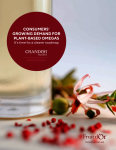Maximum levels for bioactives - the next regulatory step?
in foods and supplements looks set to be a global regulatory theme
for 2007, with the EC, several governments and the Codex committee
considering the need for risk assessment - and the recent
publication of a new report by IADSA.
Non-nutrient bioactive substances are increasingly recognised by scientists, regulatory bodies and consumers for their contribution to health and wellbeing; although they are generally regarded as non-toxic, there has been no common approach to evaluating their safety and setting maximum levels for use where necessary.
The report, prepared by the International Alliance of Dietary/Food Supplement Associations' (IADSA) scientific group, uses a detailed methodology to work out upper safe levels for a number of non-nutrient bioactives: glucosamine, chondroitin, omega-3, CoQ10, lutein, lycopene, creatine and carnitine.
Its publication last June co-incides with the hotting-up of the debate over the setting of vitamin and mineral levels for the EU as part of recent food supplement and fortified food legislation - and Simon Pettman, executive director of IADSA told NutraIngredients.com that consideration of maximum levels for other bioactives is "absolutely a next step from vitamins and minerals".
Pettman said that the report was spurred by enquiries from governments around the world following a similar report on vitamins and minerals published two years ago.
The European Commission is also presently mulling the possibility of maximum levels for bioactives, and will deliver a report on the matter before the summer.
In one sense bioactive levels could be easier to set than levels for vitamins and minerals, since there is not so much intake of many of these in functional foods.
However in some countries some bioactives are only sold as medicines. This blurring of categories and regulatory systems could pose a challenge.
What is more, bioactives were the subject of discussion at last November's session of the Codex Alimentarius committee on nutrition and foods for special dietary uses.
The committee accepted an offer by the Canadian delegation to prepare a discussion paper that would address whether current principals governing the addition of nutritional substances to foods, including bioactives, are still relevant in the light of new technologies. The paper will be presented at this November's session to be held in Germany.
However Pettman questioned the extent to which Codex will get involved in so complicated a matter. He said that four to five years ago the committee had a similar discussion over herbals but eventually decided not to tackle the matter due to its complexity.
"It could readdress it if individual governments see a need," he said. Indeed, Canada is not alone in flagging the issue. Australia is also working on risk analysis principals, and IADSA's report has been well received in Japan, the Balkans and some Latin American countries (it has been translated into Japanese and Spanish).
The problem Codex has, however, is that it does not have an entity that can provided it with scientific opinion, as, for example, the European Commission has in EFSA's scientific expert working group.
Pettman said that the IADSA method of observed safe level (OSL), is extremely similar to the WHO/FOA risk analysis approach, which was designed partly to feed back into Codex.
FAO/WHO recommend a highest observed intake (HOI) approach for substances without recognised adverse effect, however was not applied to substance at the technical workshop held in Geneva last January at which it was developed.
The guidance is intended to be used by governments considering bioactive levels, and in IADSA's view there is no need for different levels to be set in different countries.
At present, there may be five or six different levels in place for any given substance across the EU - and as many as 40 on a global basis.
"Why, is the science is the same, should there be different levels? There should be a basis for commonality of view," said Pettman.
He added that national and regional variations and variations between population groups come from dietary patterns. Broadly speaking, the variations should be relatively small.
IADSA's scientific group is presently in the process of drafting another publication on the risk assessment and safety of amino acids in food supplements, which will be available in April.













